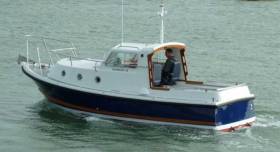Displaying items by tag: Seaward 23
Seaward 23 Power Cruiser For Sale Offers Best of Both Worlds
The boat community has a significant proportion of formerly hundred-per-cent sailing enthusiasts who have reached the stage in life where they accept that their needs might be better met by an able motoryacht writes W M Nixon
But it mustn’t be a glossy and bulbous machine which critics – themselves included – would dismiss as a gin palace. On the contrary, their ideal is a boat with a discreetly workaday character, a boat clearly related to pilot boats and patrol vessels and the like.
At the upper end of the size scale, the pace was and still is set by the Keith Nelson type. But the Nelson boats seem to work best when they’re more than 30ft long. Below that size, however, it’s the Seaward range which increasingly dominates, and the Seaward 23 has carved out her own niche in this very positive segment of the market.
So much so, in fact, that it’s almost enough to say that a Seaward 23 is the pet boat of one of Ireland’s most distinguished senior sailors, a nonagenarian who in his peak sailing days was several times Helmsmans Champion in addition to winning many major titles inshore and offshore.
If the Seaward 23 is good enough for him, then she should be good enough for the rest of us. His particular model is twin-engined, but this 1986 version for sale via Afloat.ie in Mullingar at €17,000 through Leinster Boats is single-screw with a 45hp BMW D-50 diesel, which is more than adequate power for most uses.
And having one engine makes the cockpit much more commodious. In a boat just 23ft long, the fact that there’s a substantial coachroof/wheelhouse already taking up much of the hull gives added importance to any extra space which can be provided by the cockpit. While the demo boat whose photo heads this article had not yet been fitted with a proper cockpit tent, the one in Mullingar comes with it in place, and it means the roomy cockpit is in effect a third cabin.
She’s a notably seaworthy boat, she provides full overnight accommodation for two with a proper separate toilet/washroom, in good summer weather you might even be able to set up an extra bunk or two in the cockpit, so she offers the best of both worlds between day cruiser and weekender - and all in a very manageable size package.
























































